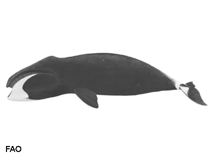Balaena mysticetus Linnaeus, 1758
Bowhead whale| Native range | All suitable habitat | Point map | Year 2050 |

|
| This map was computer-generated and has not yet been reviewed. |
| Balaena mysticetus AquaMaps Data sources: GBIF OBIS |
Classification / Names Common names | Synonyms | CoL | ITIS | WoRMS
Mammalia | Cetartiodactyla | Balaenidae
Environment: milieu / climate zone / depth range / distribution range Ecology
Pelagic. Polar; 90°N - 0°S, 180°W - 180°E
Distribution Countries | FAO areas | Ecosystems | Occurrences | Introductions
Pacific Ocean, Northern Atlantic and the Arctic. [Bering-Chukchi-Beaufort Sea population: LR/cd; Okhotsk Sea population: EN, D; Svalbard-Barents Sea (Spitsbergen) population: CR, D: IUCN 2010 (Ref. 84930)].
Length at first maturity / Size / Weight / Age
Maturity: Lm 1,400.0, range 125 - 140 cm Max length : 1,800 cm TL male/unsexed; (Ref. 1394); 2000 cm TL (female); max. published weight: 100.0 t (Ref. 1394)
Lives among the pack ice, migrating to the high arctic summer, but retreating southward in winter with the advancing ice edge. Feeds on small to medium-sized invertebrates, especially krill and copepods. Bowhead whales were heavily hunted for several centuries. Today they are partially protected by the IWC. The current world population is still threatened by small-scale hunting by Alaskan, Canadian, and Russian natives. In addition, there are various forms of habitat degradation, including disturbance from oil and gas exploration and development activities (Ref. 1394).
Life cycle and mating behavior Maturity | Reproduction | Spawning | Eggs | Fecundity | Larvae
Females calve once every 3 to 5 years, i.e., very low reproductive capacity (Ref. 118436).
Main reference
References | Coordinator | Collaborators
Jefferson, T.A., S. Leatherwood and M.A. Webber. 1993. (Ref. 1394)
IUCN Red List Status (Ref. 130435: Version 2024-1)
Least Concern (LC) ; Date assessed: 01 January 2018
CITES status (Ref. 108899)
Appendix I: International trade banned
CMS (Ref. 116361)
Appendix I: Endangered migratory species
Threat to humans
Human uses
Fisheries: commercial
FAO - Fisheries: landings, species profile | FishSource | Sea Around Us
Tools
More information
Trophic Ecology
Ecology
Population dynamics
Life cycle
Distribution
Human Related
Aquaculture profile
Stamps, Coins Misc.
Stamps, Coins Misc.
Outreach
Taxonomy
References
Internet sources
BHL | BOLD Systems | CISTI | DiscoverLife | FAO(Fisheries: species profile; publication : search) | Fishipedia | GenBank (genome, nucleotide) | GloBI | Gomexsi | Google Books | Google Scholar | Google | PubMed | Tree of Life | Wikipedia (Go, Search) | Zoological Record
Estimates based on models
Preferred temperature
(Ref. 115969): -1.7 - 1.5, mean -0.9 (based on 4244 cells).
Resilience
(Ref. 69278):
Very Low, minimum population doubling time more than 14 years (K=0.03; tm=20).
Price category
(Ref. 80766):
Unknown.



